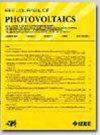硅异质结光伏组件中的裂纹建模:一个真实世界的案例研究
IF 2.6
3区 工程技术
Q3 ENERGY & FUELS
引用次数: 0
摘要
本文通过分析硅异质结光伏组件在低电流和高电流条件下的电学和热行为,研究了裂纹对硅异质结光伏组件的影响。该分析是对受严重冰雹影响的光伏组件进行的,该冰雹产生的冰雹直径达16厘米,远远超过标准测试尺寸(IEC 61215)。结合电致发光(EL)和红外(IR)热像仪,以及黑暗和光明的电流-电压表征,用于检查冰雹和操作员引起的裂缝。研究结果表明,这些裂纹是一种肉眼看不到的潜在损伤,只有通过EL和IR才能观察到,它们会导致开路电压附近的局部温度升高,而在短路条件下则会导致更均匀的分布温度升高。开发了一个Simulink/Matlab模型,以再现破裂细胞与完整细胞串联的热行为,以再现现实世界中发生的情况。研究结果强调了识别光伏组件潜在缺陷的重要性,以确保长期的可靠性、安全性和效率,并提供了对其在低电流和高电流状态下的电气和热行为的见解。本文章由计算机程序翻译,如有差异,请以英文原文为准。
Modeling Cracks in Silicon-Heterojunction Photovoltaic Modules: A Real-World Case Study
This work investigates the impact of cracks on silicon heterojunction photovoltaic (PV) modules by analyzing their electrical and thermal behavior under low and high current conditions. The analysis was conducted on PV modules affected by a severe hailstorm, which produced hailstones up to 16 cm in diameter, far exceeding the standard test sizes (IEC 61215). A combination of electroluminescence (EL) and infrared (IR) thermography, along with dark and light current–voltage characterization, was employed to examine both hail and operator-induced cracks. The findings revealed that these cracks, which are latent damages not visible to the naked eye but only with EL and IR investigations, lead to localized temperature increase near open circuit voltage, and to a more uniform distributed temperature increase near short circuit conditions. A Simulink/Matlab model was developed to reproduce the thermal behavior of cracked cells in series with intact ones, to reproduce what happens in a real-world scenario. The results emphasize the importance of identifying latent defects in PV modules to ensure long-term reliability, safety, and efficiency, offering insights into their electrical and thermal behavior in low and high current regime.
求助全文
通过发布文献求助,成功后即可免费获取论文全文。
去求助
来源期刊

IEEE Journal of Photovoltaics
ENERGY & FUELS-MATERIALS SCIENCE, MULTIDISCIPLINARY
CiteScore
7.00
自引率
10.00%
发文量
206
期刊介绍:
The IEEE Journal of Photovoltaics is a peer-reviewed, archival publication reporting original and significant research results that advance the field of photovoltaics (PV). The PV field is diverse in its science base ranging from semiconductor and PV device physics to optics and the materials sciences. The journal publishes articles that connect this science base to PV science and technology. The intent is to publish original research results that are of primary interest to the photovoltaic specialist. The scope of the IEEE J. Photovoltaics incorporates: fundamentals and new concepts of PV conversion, including those based on nanostructured materials, low-dimensional physics, multiple charge generation, up/down converters, thermophotovoltaics, hot-carrier effects, plasmonics, metamorphic materials, luminescent concentrators, and rectennas; Si-based PV, including new cell designs, crystalline and non-crystalline Si, passivation, characterization and Si crystal growth; polycrystalline, amorphous and crystalline thin-film solar cell materials, including PV structures and solar cells based on II-VI, chalcopyrite, Si and other thin film absorbers; III-V PV materials, heterostructures, multijunction devices and concentrator PV; optics for light trapping, reflection control and concentration; organic PV including polymer, hybrid and dye sensitized solar cells; space PV including cell materials and PV devices, defects and reliability, environmental effects and protective materials; PV modeling and characterization methods; and other aspects of PV, including modules, power conditioning, inverters, balance-of-systems components, monitoring, analyses and simulations, and supporting PV module standards and measurements. Tutorial and review papers on these subjects are also published and occasionally special issues are published to treat particular areas in more depth and breadth.
 求助内容:
求助内容: 应助结果提醒方式:
应助结果提醒方式:


